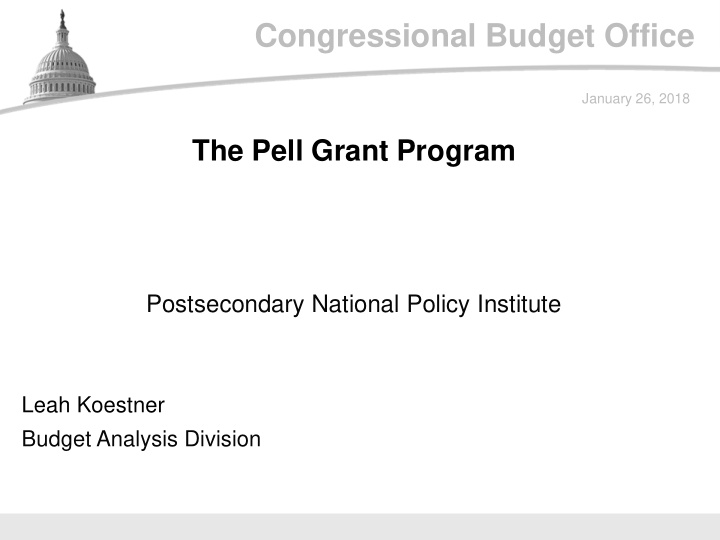



Congressional Budget Office January 26, 2018 The Pell Grant Program Postsecondary National Policy Institute Leah Koestner Budget Analysis Division
CBO Pell Grant Program Overview The Pell grant program is the largest federal postsecondary student aid grant program. – Recipients must be undergraduate students who have never received a bachelor’s degree (with some exceptions). – Eligibility and award amounts are based on a student’s income and assets (or, for students who are dependents, their parents’ income and assets). Program Projections for Award Year (AY) 2017–2018 (based on CBO’s June 2017 baseline): – 7.5 million Pell grant recipients – Total maximum award of $5,920 – Average award of about $3,800 – Total federal spending of $28.5 billion 1
CBO Components of Funding for Pell Grants Discretionary Funding – Budget authority is provided by the Congress to support the Pell program. – The maximum award (currently $4,860) is set in the annual appropriation act. Mandatory for Discretionary Pell Funding – Mandatory budget authority is available to supplement funding for the discretionary portion of the Pell grant program, as provided in the Higher Education Act (HEA). Mandatory Add-On – The mandatory add-on covers the difference between the total maximum award and the discretionary maximum award set in an appropriation act. – AY 2016–17: total maximum award = $5,815; mandatory add-on = $955 – AY 2017–18: total maximum award = $5,920; mandatory add-on = $1,060 2
CBO Discretionary Funding: CBO’s Baseline Versus Program Costs Discretionary Baseline – Constructed like all other discretionary programs – Projected as current budget authority plus an increase for inflation – Does not reflect a projection of future program costs Discretionary Program Costs – Estimated on the basis of projected changes in the number of recipients and their award levels – Incorporated an assumption of a $4,860 discretionary maximum award in all years 3
CBO How Pell Grants Are Like Entitlements Pell Scoring Rule – Even if appropriations do not provide enough budget authority to fund Pell grants in the upcoming fiscal year, CBO’s estimates include the full costs of the program. – In its cost estimates, CBO uses the higher amount of budget authority or program costs (adjusted for shortfalls or surpluses). Funding Shortfalls and Surpluses – The difference between discretionary program costs and available budget authority (through both discretionary appropriations and the mandatory for discretionary funding provided in the HEA) creates either a discretionary shortfall or a surplus. – The Pell program has had a discretionary surplus for the past six years, currently estimated at $8.5 billion. 4
CBO CBO’s June 2017 Supplemental Pell Grant Data w w w.cbo.gov/publication/51304 5
CBO Supplemental Table: Pell Grant Program Surplus 6
CBO Supplemental Table: Discretionary Program Costs 7
CBO Supplemental Table: Total Program Costs 8
CBO Appendix I: Mandatory for Discretionary $1,320,000,000 9 Note: The Consolidated Appropriations Act of 2017 Changed the Fiscal Year 2017 Mandatory for Discretionary Funding Amount. 9
CBO Appendix II: Mandatory Add-On 10 10
CBO Appendix III: Pell Scoring Rule The congressional budget resolution for fiscal year 2006 included a rule under which appropriations bills for the Pell Grant program are scored by the Congressional Budget Office for the estimated cost of the program for that year [adjusted for the cumulative shortfall/surplus], regardless of the amount actually appropriated. In years where the appropriation exceeds the program cost as estimated at the beginning of the subsequent fiscal year, any surplus is available to reduce the appropriation needed to support that subsequent year’s program costs. Conversely, in years where the appropriation is lower than the updated estimated program cost, the difference is automatically scored against the subsequent year’s appropriation. -Department of Education 11 11
Recommend
More recommend